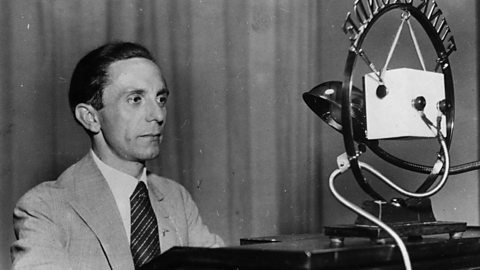The Nazi Party's lean years, 1924-1929
Hitler was released from jail after the Munich PutschA failed attempt in November 1923 by Hitler to overthrow the government of the Weimar Republic. in December 1924. He committed the Nazis to democratic politics т taking part in elections т and began to reorganise the party, strengthening his authority as leader and beginning to build a national party structure. However, the period up to 1929 is known as the Nazi Partyтs тlean yearsт because two apparently contradictory things were happening to it:
- it was growing in size т its membership increased from 27,000 in 1925 to 130,000 in 1929
- but it struggled to win seats in the ReichstagThe name of Germany's parliament.:
| Election | May 1924 | Dec 1924 | May 1928 |
| Number of seats won by the Nazis | 32 | 14 | 12 |
| Total number of seats in the Reichstag | 472 | 493 | 491 |
| Election | Number of seats won by the Nazis |
|---|---|
| May 1924 | 32 |
| Dec 1924 | 14 |
| May 1928 | 12 |
| Election | Total number of seats in the Reichstag |
|---|---|
| May 1924 | 472 |
| Dec 1924 | 493 |
| May 1928 | 491 |
Development of the Nazi Party
Party reorganisation
The decision to pursue power through democraticA system of government that allows people to have a vote. methods meant the party needed a national structure to attract members, develop polices and campaign. Hitler put this in place during 1925 and 1926.
New structure of the Nazi Party:
Propaganda - Mein Kampf
While in jail Hitler wrote a book called Mein Kampf (My Struggle), which was an autobiography-cum-manifesto, laying out his political beliefs and ambitions. Many of the ideas contained in the books directly informed Nazi policy after 1933 under the Third Reich, including:
- The belief that the Jews were an inferior race to the German AryanA person of European descent - not Jewish - often with blond hair and blue eyes. The Nazis viewed Aryans as the superior human race., and also represented a threat to the German state.
- The need to destroy the parliamentary systemThis refers to a system in which the population votes to choose representatives, who sit in parliament and pass laws. of government and replace it with that of a single, strong dictator.
- Germanyтs requirement for Lebensraum, or living space, to house its growing population. This required Germany to expand to the East into Poland and Russia.
The Bamberg Conference 1926
Hitler called a special Nazi Party conference on February 14 1926 at Bamberg in southern Germany in response to tension between the northern and southern sections of the party. During his time in jail disagreements had grown between the two sections:
- The northern section, led by a man named Gregor Strasser, was keen to emphasise the socialistSomeone who believes that society should be classless and that all property and wealth should be owned by the whole community and not by individuals. elements of the 25-Point ProgrammeThe Nazi Party's list of beliefs and polices, originally written in 1920. to attract support from the workers.
- The southern section more interested in the nationalistOne who promotes the independence of their own nation from others. and racistBeliefs or behaviour that lead to discrimination towards an individual or group because of their race. policies in order to attract support from the middle classes and farmers.
The results of the conference were:
- Hitler insisted that policies which could be painted as communistSupporters of the communist movement or party., such as taking land from rich noblemen, would not be pursued.
- However, the conference did reaffirm the 25-Point Programme, with its socialist ideas, as the partyтs policy platform.
- In addition, Hitler established the Fuhrerprinzip, or тLeader Principleт, the idea that the partyтs leader was in absolute control and all members must follow his directions. No dissentDisagreement. from this was expected or tolerated.
Reasons for limited support of the Nazi Party, 1924-28

Despite all of this development of the party, by 1928 the Nazis were still on the fringes of politics in Weimar Germany for several reasons:
- After 1923, the introduction of a new currency and the Dawes Plan had helped to turn Weimarтs economy around and Germans began to feel more prosperousWealthy.. As part of the Plan, America agreed to loan 800 million marks to Germany (although this would later cause problems).
- As a result of this, Germany was also more politically stable. Germans voted for moderate parties who supported the Republic, rather than more extreme parties like the Nazis who wanted to abolish it.
- At a time of stability, the Nazisт messages about the dangers posed by Jews and the need to abolish democracy largely fell on deaf ears.
- Hitler was jailed and then banned from speaking in public until 1927 after the Munich PutschA failed attempt in November 1923 by Hitler to overthrow the government of the Weimar Republic.. This prevented the party from campaigning effectively.
- The Nazi Party was under constant pressure from the Weimar authorities following the Munich Putsch. Several times it was banned nationally or in certain parts of Germany.
Nevertheless, the party was developing effective propagandaInformation, often biased or misleading, designed to persuade people to adopt a particular point of view. techniques under its Berlin GauleiterA local Nazi official in charge of a particular area, such as a city or region., Joseph Goebbels, which would enable it to capitalise on the economic disaster that was to strike Germany from 1929 onwards.